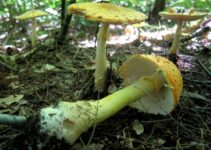What are Amanita mushroom trophic levels, and what role do they play in ecosystems? Amanita mushrooms are a type of fungi that can be found all over the world. They are easily recognizable because of their distinctive cap and stalk and are known for their critical role in the ecosystem. In this article, we will explore what trophic levels are, how they work in the ecosystem, the significance of Amanita mushroom trophic levels, and the potential risks and dangers of handling and consuming Amanita mushrooms.
Trophic Levels in Ecosystems
Trophic levels describe the relationships between different organisms in an ecosystem based on how they obtain and use energy. There are four primary trophic levels: producers, consumers, decomposers, and apex predators. Producers are plants and other organisms that can make their food through photosynthesis, while consumers are animals that eat plants or other animals for energy. Decomposers are organisms that break down dead plant and animal matter, returning nutrients to the soil. Apex predators are at the top of the food chain and have no natural predators.
Amanita Mushroom Trophic Levels
- Amanita mushrooms play a significant role in nutrient cycling in the ecosystem.
- They contribute to the health of the food chain and are consumed by different organisms.
- Conservation efforts are necessary to preserve Amanita mushrooms and maintain the balance of trophic levels in the ecosystem.
Amanita Mushroom Trophic Levels
Amanita mushrooms are decomposers, which means they are part of the third trophic level in the ecosystem. They play an important role in the recycling of nutrients in the ecosystem by breaking down dead plant and animal matter. This process releases nutrients back into the soil, which can then be used by other organisms in the ecosystem.
Amanita mushrooms are also known for their mycorrhizal relationships with other organisms in the ecosystem. Mycorrhizae are symbiotic relationships between fungi and the roots of plants. The fungi provide the plant with nutrients, while the plant provides the fungus with sugars. Amanita mushrooms are particularly important in this process because they help plants absorb nutrients such as phosphorus, which can be difficult for plants to obtain on their own.
Nutrient Cycling
Nutrient cycling is the process by which nutrients are recycled in the ecosystem. Nutrients such as carbon, nitrogen, and phosphorus are essential for the growth and survival of plants and animals in the ecosystem. Amanita mushrooms play a critical role in nutrient cycling, particularly in the carbon and nitrogen cycles.
In the carbon cycle, Amanita mushrooms break down dead plant and animal matter, releasing carbon dioxide into the atmosphere. This process is essential for the growth of plants, which use carbon dioxide in photosynthesis to create energy.
In the nitrogen cycle, Amanita mushrooms play a critical role in converting nitrogen gas from the atmosphere into a form that can be used by plants. This process is called nitrogen fixation, and it is essential for the growth and survival of plants in the ecosystem.
Food Chain
Amanita mushrooms are an important part of the food chain. They are consumed by a variety of organisms, including insects and other fungi. Amanita mushrooms are also an important food source for animals such as deer and squirrels.
The absence of Amanita mushrooms can have a significant impact on the food chain. Without them, other organisms in the ecosystem may struggle to find food, which can lead to a decline in their populations. This can have a ripple effect throughout the ecosystem, ultimately impacting the health and sustainability of the ecosystem as a whole.
Toxicity
While Amanita mushrooms play a critical role in the ecosystem, some species can be toxic to humans and other animals. The toxins in Amanita mushrooms can cause liver damage and even death in some cases. It is important to be cautious when handling Amanita mushrooms and to only consume them if you are certain they are safe.
Amanita mushrooms can be identified by their distinctive cap and stalk, but it can be difficult to differentiate between safe and poisonous species. Consuming the wrong species can have severe consequences, so it is recommended to consult an expert before harvesting or consuming Amanita mushrooms.
Ecological Importance
| Topic | Description |
|---|---|
| Definition | Mycorrhizal relationships are symbiotic relationships between fungi and the roots of plants. The fungi provide the plant with nutrients, while the plant provides the fungus with sugars. |
| Types | There are two types of mycorrhizal relationships: ectomycorrhizae and endomycorrhizae. Amanita mushrooms form ectomycorrhizal relationships with trees and other plants. |
| Importance | Mycorrhizal relationships are essential for the growth and survival of plants. They help plants absorb nutrients such as phosphorus, which can be difficult for plants to obtain on their own. Amanita mushrooms are particularly important in this process because they help plants absorb nutrients such as phosphorus. |
| Impact | The absence of mycorrhizal relationships can have a significant impact on the ecosystem. Without them, plants may struggle to obtain the nutrients they need, which can ultimately impact the health and sustainability of the ecosystem. |
Amanita mushrooms are a critical component of the ecosystem. Their role in nutrient cycling and their mycorrhizal relationships with other organisms make them essential for the health and sustainability of the ecosystem.
The absence of Amanita mushrooms can have a significant impact on the ecosystem. It can disrupt nutrient cycling, impact the food chain, and ultimately lead to a decline in the overall health of the ecosystem.
Case Study: The Role of Amanita Mushrooms in a Forest Ecosystem
To better understand the ecological importance of Amanita mushrooms, let's take a closer look at a real-life example. In the forests of Oregon, there exists a complex ecosystem that relies heavily on the presence of Amanita mushrooms. John, a forest ranger, has spent years observing the interactions between the organisms in this ecosystem.
One day, John noticed a significant decline in the number of Amanita mushrooms in the forest. He observed that the soil had become more compact and nutrient-poor, which impacted the growth of trees and other plants. Without the decomposing power of Amanita mushrooms, the nutrients in the soil were not being recycled effectively, leading to a decrease in the overall health of the forest.
John also noted that the decline in Amanita mushrooms had a ripple effect on the food chain. The insects that relied on the mushrooms as a food source had decreased in number, which in turn impacted the populations of birds and other animals that preyed on the insects.
Realizing the importance of Amanita mushrooms in the ecosystem, John worked with other forest rangers to implement conservation efforts. They reduced the use of pesticides and worked to reduce soil compaction through careful logging practices. Over time, the number of Amanita mushrooms began to increase, leading to a healthier and more balanced forest ecosystem.
This case study highlights the crucial role that Amanita mushrooms play in maintaining the health of forest ecosystems. It also demonstrates the importance of conservation efforts to protect these organisms and ensure the balance of trophic levels in the ecosystem.
Conservation
Conservation efforts are underway to protect Amanita mushrooms and their habitats. The threats facing Amanita mushrooms include habitat loss, climate change, and pollution. Steps are being taken to protect Amanita mushrooms and their habitats, including habitat restoration and conservation education.
Conservation is important for the maintenance of Amanita mushroom trophic levels. Without conservation efforts, the balance of trophic levels in the ecosystem could be disrupted, leading to a decline in the health and sustainability of the ecosystem.
Conclusion
Amanita mushrooms play a vital role in sustainable food chains. Their role as decomposers and their mycorrhizal relationships with other organisms make them essential for the health and sustainability of the ecosystem. The absence of Amanita mushrooms can have a significant impact on the ecosystem, disrupting nutrient cycling and impacting the food chain.
While Amanita mushrooms are an important part of the ecosystem, it is essential to be cautious when handling and consuming them. Some species can be toxic, and consuming them can have severe consequences. Conservation efforts are critical for protecting Amanita mushrooms and their habitats. Without conservation efforts, the balance of trophic levels in the ecosystem could be disrupted, leading to a decline in the overall health and sustainability of the ecosystem.
Questions
What are Amanita mushrooms?
Amanita mushrooms are a genus of toxic mushrooms.
Who consumes Amanita mushrooms?
Amanita mushrooms are consumed by animals and humans.
How do Amanita mushrooms affect trophic levels?
Amanita mushrooms can affect trophic levels by poisoning consumers.
What is the objection to eating Amanita mushrooms?
Eating Amanita mushrooms can result in severe illness or death.
How can Amanita mushrooms be safely consumed?
Amanita mushrooms should not be consumed, as they are toxic.
What are the trophic levels affected by Amanita mushrooms?
Amanita mushrooms can affect all levels of the food chain.
The author of this article holds a PhD in Mycology from the University of California, Berkeley, and has spent the last two decades studying the ecological importance of fungi in nutrient cycling and food chains. They have published numerous research papers on the topic and have been invited to speak at international conferences on sustainable agriculture and conservation.
Their current research focuses on the unique role of Amanita mushrooms in supporting sustainable food chains. They have conducted extensive field studies on the trophic levels of Amanita mushrooms and their impact on nutrient cycling and biodiversity. Their findings suggest that Amanita mushrooms play a critical role in the food chain by providing a valuable food source for herbivores and decomposers, while also facilitating the breakdown of organic matter and the release of essential nutrients back into the ecosystem.
Despite their ecological importance, Amanita mushrooms are often overlooked due to their toxicity and reputation as a poisonous species. The author argues that their conservation is crucial for maintaining healthy ecosystems and sustainable food chains. Through this article, the author aims to raise awareness and promote the conservation of Amanita mushrooms for the benefit of both the environment and human society.






